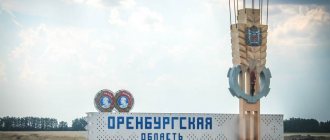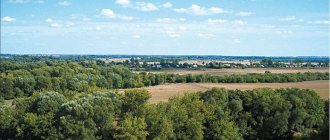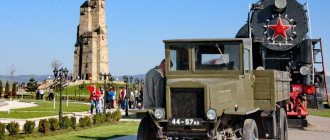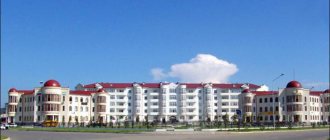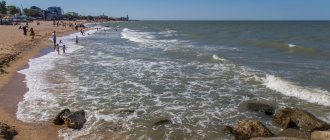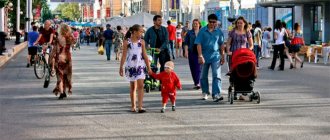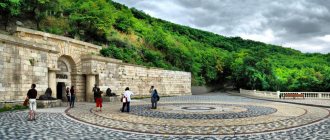see also
- Ingushetia
- Symbols and sights of Ingushetia
- Cities of Russia
| [ + ] Cities by regions of Russia | |
| Cities of the North-West (NWFD) | St. Petersburg (and its cities) • Leningrad region (historical Staraya Ladoga) • Arkhangelsk region • Vologda region • Kaliningrad region • Karelia • Komi • Murmansk region • Nenets Autonomous Okrug • Pskov region |
| Cities of the Volga region (Volga Federal District) | Bashkortostan • Volgograd region • Kalmykia • Kirov region • Mari El • Mordovia • Nizhny Novgorod region • Orenburg region • Penza region • Perm region • Samara region • Saratov region • Tatarstan • Udmurtia • Ulyanovsk region • Chuvashia |
| Cities of Southern Russia (SFD) | Sevastopol (including Inkerman) • Republic of Crimea • Adygea • Astrakhan region • Krasnodar region • Rostov region |
| Cities of the North Caucasus (NCFD) | Dagestan • Ingushetia • Kabardino-Balkaria • Karachay-Cherkessia • North Ossetia - Alania • Stavropol Territory • Chechen Republic |
| Cities of the Urals (Ural Federal District) | Kurgan region • Sverdlovsk region • Tyumen region • Khanty-Mansi Autonomous Okrug - Yugra • Chelyabinsk region • Yamalo-Nenets Autonomous Okrug |
| Cities of Siberia (Siberian Federal District) | Altai Republic • Altai Territory • Irkutsk Region • Kemerovo Region • Krasnoyarsk Region • Novgorod Region • Novosibirsk Region • Omsk Region • Tomsk Region • Tyva • Khakassia |
| Cities of the Far East (FEFD) | Amur Region • Buryatia • Jewish Autonomous Region • Trans-Baikal Territory • Kamchatka Territory • Magadan Region • Primorsky Territory • Sakha (Yakutia) • Sakhalin Region • Khabarovsk Territory • Chukotka Autonomous Region |
| see also | Cities of the DPR, LPR, Transnistria, South Ossetia • Regions of Russia • Cities of Russia |
Ingush cities and their features
Those who wonder how many cities there are in Ingushetia will be surprised - after all, there are only five of them in the republic, of which one became a city of republican significance only in 2016. However, this fact does not mean that before all five settlements were given city status, they were nothing. Each has its own history, closely connected both with the republic itself and with the influence of greater Russia.
Here is a list of cities in Ingushetia today:
- Magas
- Nazran
- Karabulak
- Sunzha
- Malgobek
What are Ingush cities and what are the features of each of them? It is worth studying the history of each of them in more detail.
- Magas.
This is the capital of the republic, and one of its youngest cities. Its name translated from Ingush sounds poetic - “city of the sun”. Once on this territory there was another Magas - the capital of Alanya. Until now, archaeologists periodically carry out excavations here; within the city’s borders there are over two dozen fortifications dating back to the first millennium.
The modern city emerged quite recently - the first stone of its foundation was laid just in 1994. And on April 15 of the same year, Boris Yeltsin signed a decree launching the process of building the Republic of Ingushetia. Today, April 15 is considered City Day and is widely celebrated by the population. Since this city was originally conceived as an administrative center, there will not be any large enterprises in it. But it is very cozy and always welcomes guests. It is home to about 7,000 people, most of whom are Ingush.
- Nazran.
The oldest and one of the largest cities in the region in terms of population. There are more than 113 thousand people here, which is a record for the republic. Nazran was founded in 1781 as a Russian fortification. Later, a settlement was located next to it, a school for children appeared, and at the end of the 19th century a railway station was built. Before the decision was made to give Magas capital status, the capital of the region was located in Nazran. Currently, there are several industrial enterprises operating here, and there is a developed infrastructure.
- Karabulak.
It is located on the left bank of the Sunzha River. The name itself is translated from Turkic as “black spring”; the city is the second most populous in the republic - approximately 40 thousand residents live here. Karabulak cannot be called a young city; it was founded in 1859 as a Cossack village.
This fact once again proves how intricately intertwined the ties between Russia and the North Caucasus were. By the way, Karabulak became a city of republican significance in 1995, before which it was considered a village. Before perestroika, both Ingush and Russians lived here in approximately equal proportions. However, after ethnic clashes began in 1991, the Russian indigenous population began to leave the city. Today, almost 98% of Karabulak are Ingush.
- Sunzha.
This settlement was founded in 1845 by the Cossacks during the Caucasian War. Initially it was the village of Sunzhenskaya, during the war in 1852 it was named after Major General N.P. Sleptsov, and later in 1939 it was renamed Ordzhonikidzevskaya. In 2015, it was renamed Sunzha with the status of an “urban-type settlement”, and in 2016 it became a city.
Thus, this is the newest city in Ingushetia. The population is about 65 thousand people who work at several enterprises in the city. By the way, it was in Sunzha that the Ingush State University was opened; now only a few small buildings remain there, the rest have been moved to Magas. Among the industrial enterprises, a creamery and cheese factory is located here.
- Malgobek.
Until the 30s of the twentieth century, it was a small village of Voznesenskoye (the name also indicates its Russian origin). However, after oil deposits were discovered in the surrounding area, the area began to be actively populated and developed. First, Voznesenskoye was renamed the village of Malgobek, and in 1939 it received the status of a city.
Malgobek is quite young, the people who started building it are still alive. Since the city arose thanks to oil development, the city-forming enterprise is an oil concern. Today Malgobek continues to expand and has a great future. In 2007 it received the honorary title “City of Military Glory”.
What to see in Ingushetia
The largest tourist attraction is the Dzheirakh-Assinsky historical and architectural reserve. It unites the Myatsil sanctuary, the ancient buildings of the village of Beini, the tower-type castle-type settlement of Falkhan with a majestic necropolis of 12 tombs, the impregnable Metskhal complex, the villages of Erzi, Egi-Kale, Targim and several others.
View this post on Instagram
Posted by Roman Gavrilov (@rogavr) Oct 15, 2022 at 7:41 PDT
In total, there are about two thousand objects of historical and architectural heritage in these parts. Unfortunately, tourists love to climb into the ruins, decorate them with inscriptions and graffiti, and often leave garbage behind, but the management of the reserve is making every effort to restore architectural monuments and improve the territory.
The most recognizable monuments of Ingushetia are ancient battle towers in the mountains. The most famous of them is the Vovnushki castle complex at the entrance to the Guloy-khi River gorge. Two castles on its banks were once connected by a bridge, which was part of the Great Silk Road.
View this post on Instagram
Posted by This is the Caucasus (@etokavkaz)Nov 22, 2022 at 1:17 PST
In the Assinsky gorge, located nearby, between the villages of Khairakh and Pui, there is the Christian temple of Thaba-Erdy, founded in the 18th century. Its architecture combines the features of Georgian and Ingush architecture.
View this post on Instagram
Posted by Eddi (@t.eddi)Nov 6, 2022 at 3:40 PST
Dzheirakhsky district of Ingushetia is a border zone. When going there, be sure to take your passport with you. This is enough if you are not going to get closer than five kilometers to the border. To visit places in the immediate vicinity of the border, you must obtain an individual or group pass. Contact the Border Department of the FSB of Russia for the Republic of Ingushetia at the address Magas, Gorchkhanova Street, building 11 (telephone).
View this post on Instagram
Posted by Makeup Artist|Model|Moscow (@blue_puma)Oct 24, 2022 at 9:21 PDT
Few people live in the mountains. Traveling around Ingushetia, only occasionally you will come across herds of sheep with shepherds and their dogs and small villages. Most of the way you will be surrounded only by untouched mountains, gorges and rivers, ruins of ancient castles and fortresses and clear skies above your head.
View this post on Instagram
Posted by Oksana (@oxy_kroxy) Feb 6, 2022 at 3:42 PST
Sights of the region
Ingushetia is a fairly young republic, which is confirmed by the history of its cities. However, this land is ancient and people lived here centuries ago. If you drive through villages and cities, you can see a lot of interesting things.
For example, near Magas there is “Acham-Boarz” - a settlement where tourists try to go on excursions. Here, in the capital, is the tallest Ingush building, the Tower of Concord.
And in Nazran a Memorial of Memory and Glory was erected. It was erected in due time so that residents and guests of the republic would remember the heroes of the wars in which Russia was forced to take part, and the people who fell victims of the repressions of 1944. In addition, on the territory of the city there is the Borga-Kash mausoleum, built in the 15th century, and you can also see an ancient Russian fortress.
Those who come to Karabulak can visit the Republican Museum of Fine Arts. In the same city there is a church of the icon of the Kazan Mother of God - this is one of the Orthodox churches that exist in very small numbers in Ingushetia. But the main decoration of the cities of Ingushetia is, of course, nature. It is precisely this that serves as the background against which all five cities become a real necklace of a young, but such a promising region.
Distance tables of countries of the world
- Distance between cities of Azerbaijan
- Distance between cities in Armenia
- Distance between cities in Belarus
- Distance between cities in Georgia
- Distance between cities in Kazakhstan
- Distance between cities in Mongolia
- Distance between Russian cities
- Distance between cities in Turkmenistan
- Distance between cities in Turkey
- Distance between cities of Uzbekistan
- Distance between cities in Ukraine
- Distance between cities in Eurasia
- Distance between European cities
- Distance between CIS cities
Population
| Population | |||||||||
| 1926[2] | 1931[3] | 1959[4] | 1970[5] | 1979[6] | 1987[7] | 1989[8] | 1990[9] | 1991[9] | 1992[9] |
| 75 133 | ↗81 900 | ↗710 424 | ↗1 064 471 | ↗1 153 450 | ↗1 235 000 | ↗1 275 513 | ↘189 340 | ↗192 642 | ↗194 105 |
| 1993[9] | 1994[9] | 1995[9] | 1996[9] | 1997[9] | 1998[9] | 1999[9] | 2000[9] | 2001[9] | 2002[10] |
| ↗195 821 | ↘194 171 | ↗263 092 | ↗282 342 | ↗291 209 | ↗296 294 | ↗301 745 | ↗340 028 | ↗445 443 | ↗467 294 |
| 2003[9] | 2004[9] | 2005[9] | 2006[9] | 2007[9] | 2008[9] | 2009[9] | 2010[11] | 2011[12] | 2012[13] |
| ↗468 773 | ↗475 645 | ↗481 565 | ↗486 970 | ↗492 669 | ↗499 502 | ↗508 090 | ↘412 529 | ↗414 524 | ↗430 495 |
| 2013[14] | 2014[15] | 2015[16] | 2016[17] | 2017[18] | 2018[19] | 2019[20] | 2020[21] | 2021[22] | 2022[1] |
| ↗442 255 | ↗453 010 | ↗463 893 | ↗472 776 | ↗480 474 | ↗488 043 | ↗497 393 | ↗507 061 | ↗515 564 | ↗523 955 |
Note. 1936−1944 and 1957−1989 - data for Checheno-Ingushetia
Note. 1936−1944 and 1957−1989 - data for Checheno-Ingushetia
| Fertility (number of births per 1000 population) (1936-1944 and 1857-1991 - including data for the Chechen Republic) | ||||||||
| 1970[23] | 1975[23] | 1980[23] | 1985[23] | 1990[23] | 1995[23] | 1996[23] | 1997[23] | 1998[23] |
| 21,1 | ↘20,3 | ↗20,9 | ↗25,1 | ↘24,6 | ↘23,8 | ↘19,7 | ↘19,5 | ↘18,8 |
| 1999[23] | 2000[23] | 2001[23] | 2002[23] | 2003[24] | 2004[24] | 2005[24] | 2006[24] | 2007[25] |
| ↘16,4 | ↗17,8 | ↗18,9 | ↘16,1 | ↘14,9 | ↘14,2 | ↘14 | ↗15,1 | ↗16,7 |
| 2008[25] | 2009[25] | 2010[25] | 2011[26] | 2012[27] | 2013[28] | 2014[29] | ||
| ↗18,3 | ↗18,7 | ↗27,3 | ↘25,9 | ↘22,6 | ↘21,4 | ↘20,7 | ||
| Mortality (number of deaths per 1000 population) (1936-1944 and 1857-1991 - including data for the Chechen Republic) | |||||||||
| 1970[30] | 1975[30] | 1980[30] | 1985[30] | 1990[30] | 1995[30] | 1996[30] | 1997[30] | 1998[30] | 1999[30] |
| 5,7 | ↗5,8 | ↗6,6 | ↗8,3 | ↗8,5 | ↘6,4 | ↗6,5 | ↘6,3 | ↗6,5 | ↘4,8 |
| 2000[30] | 2001[30] | 2002[30] | 2003[31] | 2004[31] | 2005[31] | 2006[31] | 2007[32] | 2008[32] | 2009[32] |
| ↘4,5 | ↘4 | →4 | ↘3,8 | ↘3,7 | ↗3,8 | ↘3,7 | ↘3,3 | ↘3,1 | ↗3,7 |
| 2010[32] | 2011[33] | 2012[34] | 2013[35] | 2014[36] | |||||
| ↗4,5 | ↘4,1 | ↘3,7 | ↘3,5 | →3,5 | |||||
| Natural population growth (per 1000 population, the sign (-) means natural population decline) (1936-1944 and 1857-1991 - including data for the Chechen Republic) | ||||||||
| 1970[37] | 1975[38] | 1980[39] | 1985[40] | 1990[41] | 1995[42] | 1996[43] | 1997[44] | 1998[45] |
| 15,4 | ↘14,5 | ↘14,3 | ↗16,8 | ↘16,1 | ↗17,4 | ↘13,2 | →13,2 | ↘12,3 |
| 1999[46] | 2000[47] | 2001[48] | 2002[49] | 2003[50] | 2004[50] | 2005[50] | 2006[50] | 2007[51] |
| ↘11,6 | ↗13,3 | ↗14,9 | ↘12,1 | ↘11,1 | ↘10,5 | ↘10,2 | ↗11,4 | ↗13,4 |
| 2008[51] | 2009[51] | 2010[51] | 2011[52] | 2012[53] | 2013[54] | 2014[55] | ||
| ↗15,2 | ↘15 | ↗22,8 | ↘21,8 | ↘18,9 | ↘17,9 | ↘17,2 | ||
| Life expectancy at birth (number of years) (1936-1944 and 1857-1991 - including data for the Chechen Republic) | ||||||||
| 1990[56] | 1991[56] | 1992[56] | 1995[56] | 1996[56] | 1997[56] | 1998[56] | 1999[56] | 2000[56] |
| 69,7 | ↗69,8 | ↗70,4 | ↘68,8 | →68,8 | ↗69,5 | ↘67,9 | ↗70,2 | ↗72 |
| 2001[56] | 2002[56] | 2003[56] | 2004[56] | 2005[56] | 2006[56] | 2007[56] | 2008[56] | 2009[56] |
| ↗74,8 | ↘74,4 | ↗74,8 | ↗75,9 | ↘75,6 | ↗76 | ↗79 | ↗80,1 | ↘78,3 |
| 2010[56] | 2011[57] | 2012[57] | 2013[57] | |||||
| ↘74,7 | ↗76,3 | ↗77,8 | ↗78,8 | |||||
How to get to Ingushetia
runs several times a week, the journey takes about 30 hours. Neighboring cities that can also be reached to visit the republic are Vladikavkaz, Grozny and Nalchik. There is an airport in Magas; it receives three daily flights from Moscow; they are carried out by Avia, Pobeda and Utair. The nearest airports are in Beslan, Nalchik and Grozny.
Roads in Ingushetia, especially mountain roads, are not in the best condition, although there is more and more asphalt pavement every year. Our advice: spare your car and use the services of local travel agencies, whose employees know exactly where and how they can get there. By the way, some serpentines look very impressive, and this is another reason to use the services of a driver who will drive along them not for the first time. He will be able to tell you about the amazing history of these places and will organize a hospitable reception in any place where you find yourself during your trip.
In Ingushetia, a helicopter tour was organized from Magas to the Dzheirakh region to the foot of Table Mountain (Myat-lom, height 3003 meters). The program includes a visit to the tower complexes, including Vovnushki and Tsori, as well as the Thaba-Erdy temple. During the flight you will see panoramas of mountainous Ingushetia and architectural monuments on the peaks, which are extremely difficult to reach. The price of such a tour is 35 thousand rubles; Duration: five hours.
View this post on Instagram
Posted by Akhmed Lyanov (@akhmed__lyanov) Jul 31, 2022 at 11:10 PDT
Cities[ | ]
| № | Name | city of republican significance[3] | population (persons) | foundation first mention | city status | coat of arms | former names |
| 1 | Karabulak | Karabulak city | ↗43 549[2] | 1859 | 1995 | Karabulakskaya (until 1962) | |
| 2 | Magas | Magas city | ↗13 601[2] | 1995 | 2000 | ||
| 3 | Malgobek | Malgobek town | ↗39 096[2] | 1934 | 1939 | Voznesenskoye (until 1934) | |
| 4 | Nazran | Nazran city | ↗124 169[2] | 1781 | 1967 | Costa Khetagurovo (1944-1959) | |
| 5 | Sunzha | Sunzha city | ↗66 807[2] | 1845 | 2016 | Sunzhenskaya (until 1852), Sleptsovskaya (1852-1939), Ordzhonikidzevskaya (1939-2016) |
